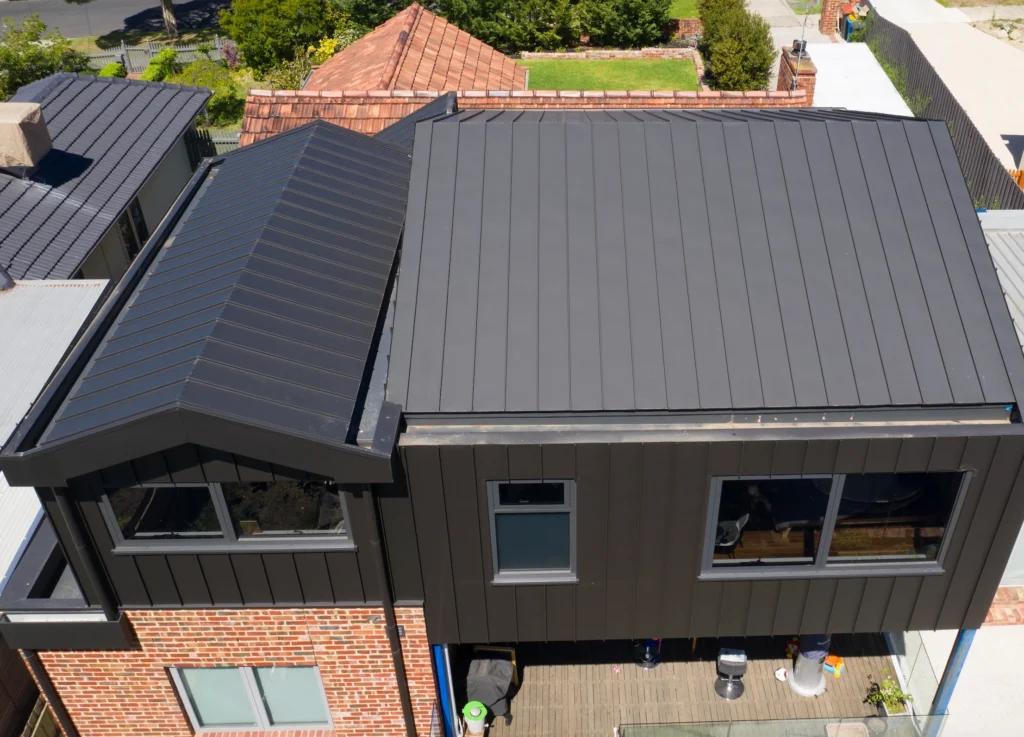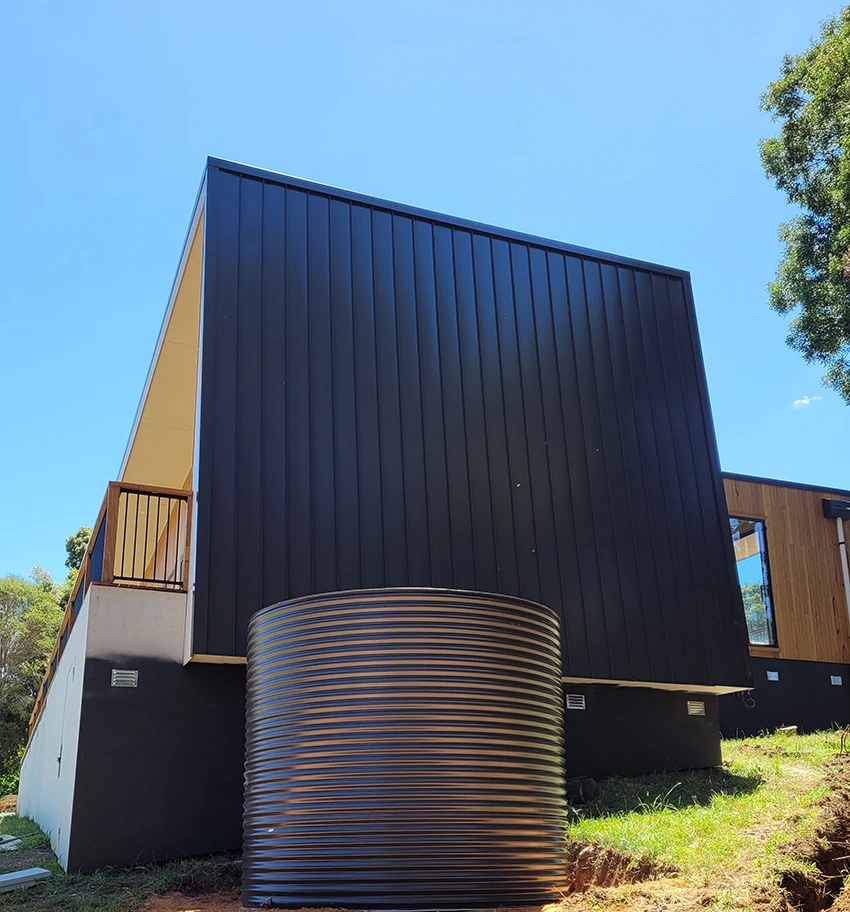TL;DR: Standing seam cladding is a premium metal roofing and wall system made from interlocking panels with raised seams that snap or fold together. It delivers a sleek, modern look while offering outstanding durability, weather resistance, and low maintenance. In Australia, it’s widely used across both residential homes and commercial projects because it suits a variety of architectural styles and performs well in harsh climates.
What Is Standing Seam Cladding
Standing seam cladding is a metal cladding system where long, vertical panels interlock at the seams. The result is a smooth surface with minimal visible fasteners. You might see it on modern homes, commercial complexes, and even heritage renovations. In Australia, many builders and roofing experts choose standing seam cladding for its clean lines and proven weather resistance.
You can think of it as a refined version of traditional metal cladding. With standing seam, each panel is raised at the edge, creating a “standing” seam that locks into the next panel. If you need a more general background on how outer coverings protect a structure, feel free to look at whats cladding.
Why it’s popular in Australia
- Robust against rain, extreme heat, and strong winds.
- Delivers a neat, modern design.
- Ideal for various building shapes, from single-storey homes to multi-level offices.
Some local contractors note that homeowners often combine it with other building materials, like timber or rendered walls, to create striking visual contrast. By blending styles, you can showcase an architectural statement without sacrificing durability.

How Does Standing Seam Cladding Work
Standing seam cladding relies on a few key elements working together to protect your home or commercial building and maintain its striking look.
Panels
Panels are the long sheets of metal (often steel, aluminium, or zinc). They’re cut into narrow widths for easy handling, then formed with raised edges. These edges are what allow for that characteristic “standing” seam.
Seams and fixings
Each panel’s raised edges lock or snap together with the next panel. Skilled installers use special tools to fold and seal the seams, ensuring a watertight barrier. Hidden fixings or clips attach each panel to the underlying structure, so you won’t see rows of screws on the surface.
Substrate
Below the panels, you usually have a plywood or metal substrate. This layer adds structural support and a flat surface. A breathable membrane might also be placed between the substrate and the metal panels to manage condensation.
Weigh pros and cons
Like any major building material, standing seam cladding offers clear advantages, but it’s not without a few drawbacks. Here’s the pro’s and con’s we’ve found from years of cladding at Top Glaze Roofing
Advantages
- Long-lasting protection: Properly installed and maintained, standing seam systems often last 40+ years.
- Weather resistance: The interlocking seams are tough against Aussie wind and rain, reducing the risk of leaks.
- Low-maintenance finish: Most metal panels only need occasional cleaning to remove dirt or debris.
- Modern style: A sleek silhouette gives your property a contemporary edge, boosting curb appeal.
- Energy efficiency: Many metal cladding profiles, including standing seam, help reflect heat on hot days, keeping indoor areas cooler.
Drawbacks
- Cost: The high-quality materials and skilled labour can push up your initial budget.
- Specialist installation: Not all roofers or builders have the training to install standing seam systems correctly.
- Potential for oil canning: Slight ripples or waves may appear if the panels expand or contract, especially with thin metals. To learn more, see what is oil canning.
Overall, if you’re aiming for a bold, modern look that can handle Australia & Melbourne’s variable climate, standing seam cladding is a solid choice. Just make sure you work with professionals experienced in metal cladding.

Plan the installation
At Top Glaze we’ve always found spending the extra few days planning and understanding the specifics of a project can save you time in the long run, ensure a high-quality finish, and help you manage costs. Here is the process for any standing seam cladding install
- Assess the structure
Have a professional examine your walls or roof for any structural issues. They’ll check framing, alignment, and any existing waterproofing. - Choose materials
Decide on the metal type (colour-coated steel, aluminium, zinc, etc.). In Australia, pre-painted steel is common, with designated colour palettes to meet local aesthetic preferences. - Measure and design layout
Accurate measurements are crucial. Sloppy numbers lead to uneven panels or unattractive overlaps. This step often involves drawing up a layout plan to position seams symmetrically. - Install the substrate and membrane
A plywood or metal deck provides the base. Then, a breathable membrane may be installed to reduce condensation. - Attach panels
Each metal panel is placed with clips or concealed fasteners. Seams are then locked or folded together to create that distinct vertical line. - Inspect and finish
Once everything is secure, the installer checks for issues such as loose seams or small gaps. A final inspection ensures watertight integrity.
Tips for success
- Get professional advice upfront. Standing seam cladding can be tricky, so partnering with a seasoned installer is key.
- Avoid moisture build-up by using appropriate membranes and vented trims.
- Confirm local regulations. Certain states in Australia have codes that dictate how metal cladding must be fastened or how lightning protection should be handled.
Standing Seam Cladding Vs Other Options
Standing seam cladding is not your only metal cladding option. Systems like snaplock or traditional corrugated panels come with their own benefits. Here’s a quick side-by-side look:
| Feature | Standing seam | Snaplock | Corrugated Metal |
|---|---|---|---|
| Seam/locking method | Folded seam panels | Pre-formed snap-on ribs | Overlapping ridges |
| Visual profile | Smooth, flat surface with tight seams | Similar contemporary look, slightly simpler to install | Classic wavy pattern |
| Installation complexity | Requires skilled labour | Moderate skill required | Generally simpler |
| Cost range (approx.) | Higher upfront investment | Moderate | Often more budget-friendly |
| Typical use | Premium residential, commercial | Modern renovations, smaller projects | Traditional homes, sheds, barns |
If you like the aesthetic of standing seam but prefer an easier or sometimes cheaper installation, you might consider snaplock. For a more classic Australian feel, many homeowners still choose corrugated metal. Each path can offer good protection, so your choice often boils down to style, budget, and the complexity of your building.
Costs and Maintenance
Many factors influence what you’ll pay for standing seam cladding, including panel material, the size and shape of your build, plus labour rates. Metal cladding can cost around $150 to $220 per square metre installed, though prices vary depending on location and the complexity of the design. If you want a ballpark figure for your project, try the cladding cost calculator. You might also check out the Top Glaze house cladding cost for more detail on general pricing.
Common cost considerations
- Materials: Steel vs. aluminium vs. zinc can shift your total dramatically.
- Complexity: More corners, dormers, or detailed trims increase labour fees.
- Extra finishes: You can add paint or a special coating for improved corrosion resistance.
- Roof vs. wall: Installing standing seam on a pitched roof can cost more than on vertical walls, given the safety measures and equipment required.
Maintenance tips
- Clean occasionally: A simple rinse with water usually removes dirt or salt residue, particularly important in coastal areas.
- Check for damaged fasteners: At least once a year, or after severe weather, do a quick inspection to make sure everything is still secure.
- Keep gutters clear: Blocked gutters can cause water backing up, increasing the risk of leaks along roof edges.
Frequently asked questions
- How long does standing seam cladding last?
With proper installation and maintenance, your standing seam panels can last 40 years or more. Regular cleaning, checking for loose seams, and repairing minor issues will help extend this lifespan. - Is standing seam cladding suitable for coastal areas?
Yes, it can perform very well in salty or coastal environments, provided you choose corrosion-resistant metals like aluminium or appropriately coated steel. Also, rinsing away salt deposits every few months can preserve its finish. - Will it reduce noise from rain or hail?
Metal cladding can sometimes amplify the sound of heavy rain or hail, but proper substrate, insulation, and membrane layers help dampen noise. Standing seam in particular uses secure seams that reduce panel vibration. - Does it require special approvals in Australia?
In most cases, you only need a standard building permit or development approval, depending on your local council regulations. Complex commercial projects or heritage zones may require more specific permissions. Always consult with a certified builder or local authority for confirmation.
Review your next steps
Standing seam cladding adds a sleek, modern accent to many Australian homes and commercial properties. Between its durable surface, interlocking seams, and low-maintenance finish, it’s hard to beat if you value longevity. Just remember to weigh its higher initial cost against its impressive lifespan, and look for a qualified cladding installer in Melbourne like Top Glaze Roofing to ensure you get a seamless finish.
If you’re still exploring your options, you can start by getting a detailed quote using the house cladding cost or cladding cost calculator. Then, talk to us here at Top Glaze Roofing, to get feedback on materials, energy efficiency, warranties, and more. Take that first step now, and you’ll have a sleek, protective exterior to enjoy for decades to come.
